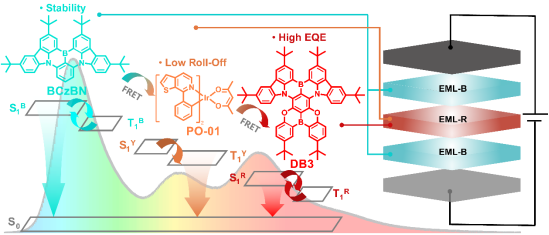On February 11, 2025, Professor Yang Chu Luo's research team from the College of Materials Science and Engineering at Shenzhen University published a research paper titled "High-power-efficiency and ultra-long-lifetime white OLEDs empowered by robust blue multi-resonance TADF emitters" in the internationally renowned journal Light: Science & Applications. The paper is available at: https://www.nature.com/articles/s41377-025-01750-z.
White organic light-emitting diodes (WOLEDs) are regarded as highly promising next-generation lighting sources due to their potential advantages such as flexibility, low power consumption, and eye-friendly illumination. However, the lack of stable blue emitters capable of efficiently utilizing triplet (T1) excitons has significantly limited the power efficiency and operational lifetime of WOLEDs, posing a critical bottleneck for their future large-scale commercialization.
Recently, Professor Chuluo Yang’s team proposed a strategy of incorporating stable blue multi-resonance thermally activated delayed fluorescence (MR-TADF) emitters into three-color WOLEDs, combined with precise tuning of complementary blue emissions to achieve entire visible spectrum coverage. This approach not only realizes high-quality white light emission but also effectively addresses the challenges of efficiency and device lifetime. Experimental results demonstrated that the devices achieved a maximum external quantum efficiency (EQEmax) of 34.4% and a maximum power efficiency (PEmax) of 101.8 lm W-1. Furthermore, the device achieved an LT90 (the time for luminance to drop to 90% of its initial value) of 761 hours, representing one of the highest operational lifetimes reported for WOLEDs to date.

Light: Science & Applications has an impact factor of 20.6 and is classified as a Category I journal by the Chinese Academy of Sciences, making it among the top-tier journal in the international field of optics. Chen Guohao, a master's student at the College of Materials Science and Engineering, Shenzhen University, is the first author of this study. Assistant Professor Miao Jingsheng and Professor Yang Chuluo, also from the same college, are the co-corresponding authors. Shenzhen University is the sole institution contributing to this research. This study was supported by the National Natural Science Foundation of China, the Natural Science Foundation of Guangdong Province, the Shenzhen Science and Technology Plan, and Shenzhen University.
